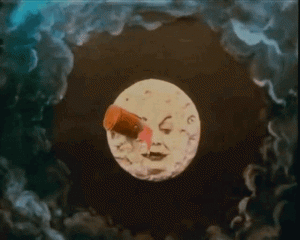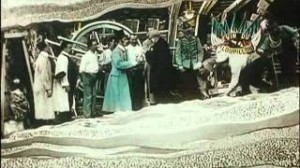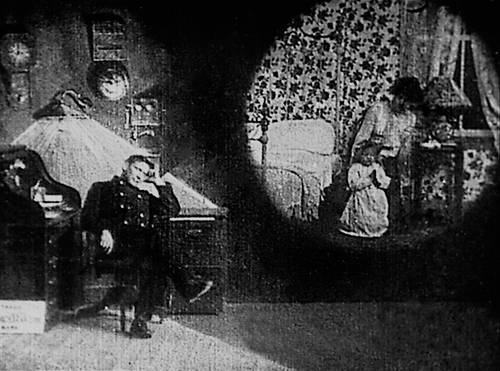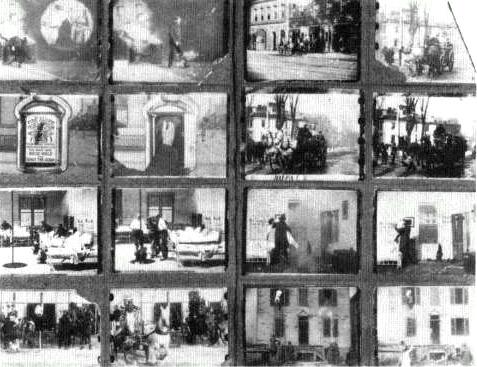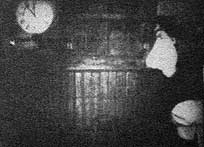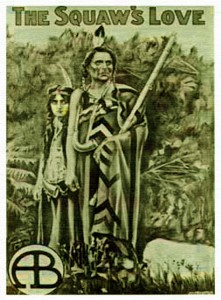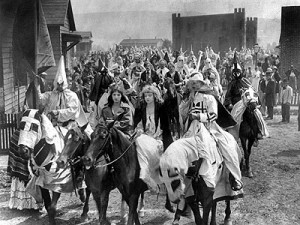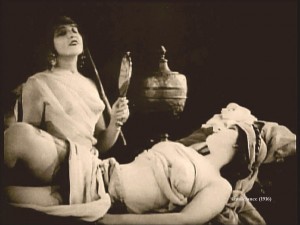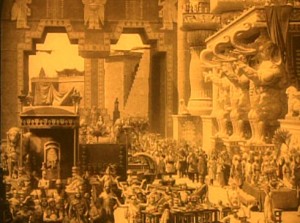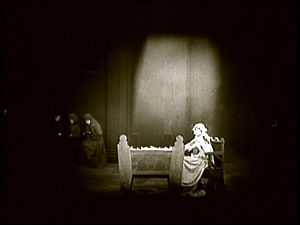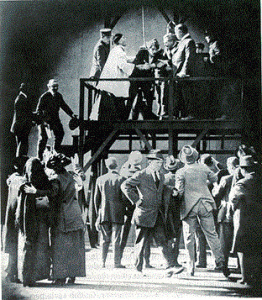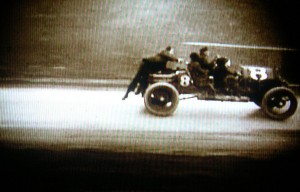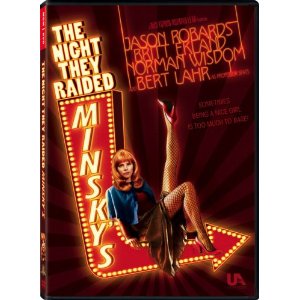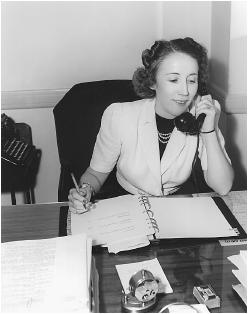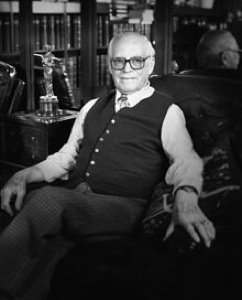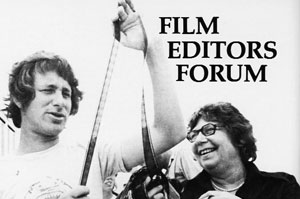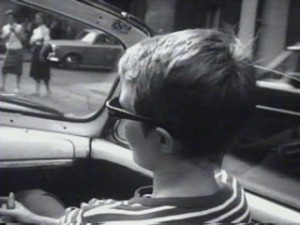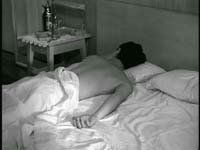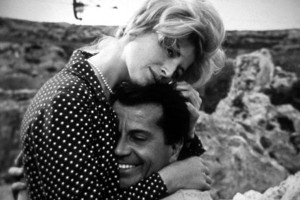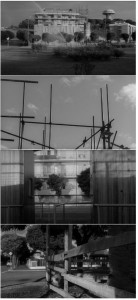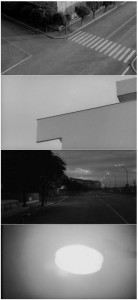From The Movie, Chapter 108, 1982. -– J.R.
The earliest principles of editing shots together were perhaps no more simple or complex than those of bricklaying; they served, at any rate, to perform the same sort of basic architectural function. In an early narrative film by Georges Méliès, Le Voyage dans la lune (1902, A Trip to the Moon), elaborately staged tableaux in front of a stationary camera — the filmmaker himself called them ‘artificially arranged scenes’ — succeed one another through the medium of dissolves. A bevy of chorus girls waves goodbye to a rocket ship fired from a cannon (one tableau), the moon is seen approaching (another tableau, effected through a moving, artificial moon rather than a moving camera), and the rocket ship lands splat in the eye of the Man in the Moon (still another tableau). By the time Méliès was making Le Tunnel sous la Manche ou le Cauchemar Franco-Anglais (l907, Tunneling the English Channel), five years later, his visual structures were more complex, so that an entire narrative could proceed in the form of individual split-screen diptychs. In each of them, an Englishman and Frenchman attempt to cross the channel towards each other from opposite sides of the screen. Yet even here, the complexity is entirely a matter of what is contained within the shots, not what happens between them.
On the other side of the Atlantic, however, Edwin S. Porter, a cameraman working for Thomas Edison, was experimenting with a quite different principle of telling a story in two films he directed. The Great Train Robbery and Life of an American Fireman (both 1903). The latter film begins with a somewhat fanciful tableau; a fire-chief asleep in his chair is seen dreaming of a woman and a child inside a burning house, the latter appears as a vignette or ‘dream balloon’ over his head. Then, in quick succession, we see the fire alarm being sounded, firemen getting out of their dormitory beds and sliding down a pole into the engine house, the fire engines starting up, the doors of the fire station opening, the fire engines leaving. Then, after an already classic ‘to the rescue’ chase sequence of the horse-drawn fire trucks rushing to the scene of the fire — put together from stock shots culled from previous Edison films — Porter took two radically unprecedented steps. First, he cut to a studio set of the burning house’s interior, where the woman calls from the window for help before collapsing on a bed; a ladder and subsequently a fireman arrive at the window to save her and her child; then the fire is extinguished. Secondly, he cut to an exterior of a burning house that proceeded to show the same sequence of events already seen in the previous shot.
Audiences were confused, perhaps because the thread of the story was broken by the repetition of events — which could imply that the second sequence must, in narrative time, follow on from the first. As audiences could not accept this form of instant replay, a differently edited version of Life of an American Fireman was also made. The second version cuts freely between the inside and outside of the burning house to render the whole sequence of events only once, but from alternating viewpoints.This solution offers an early example of the capacity of editing to create an imaginary unity of place and event (significantly, Porter filmed the interior and exterior sequences in separate locations, many miles apart) -– an approach that is perceived by audiences as analytical, or breaking a single event into smaller units.
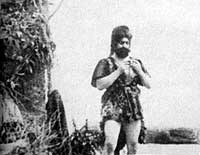
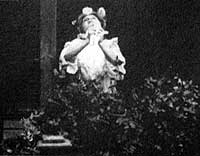
The development, expansion and elaboration of this principle in the films of D. W. Griffith began only five years later, when he embarked on his prolific career as a film director for the American Mutoscope and Biograph Company in 1908 -– making no less than 136 films during his first year at the job. Cross-cutting can indeed be discerned in both his eleventh film, The Fatal Hour, and his thirty-fourth, After Many Years [see above photos], but it was while shooting his twelfth film, For Love of Gold, that he asked for a second shot of a particular scene to be taken from a new position which was closer to the actors, and asked that the two shots be spliced together in the finished film. (In The Squaw’s Love, made in 1911, he extended this notion by filming an almost unrepeatable stunt with three cameras at once.)
All in the head
To understand the importance of Griffith’s contribution to the art of editing as we know it today, it is important to appreciate that the work was essentially all done in his head, at least during the formative stages of his career. The film historian and Griffith biographer Seymour Stern emphasizes the significance of Griffith’s ‘directorial editing’ — how he shot such films as The Birth of a Nation (1915) and lntolerance (7916) without the benefit of scripts or even notes in the ordinary sense. In fact, Griffith largely edited films as he directed them. John Ford, a Griffith disciple, made films in a similar manner, so that they could be edited essentially only one way afterwards.
The fact that Griffith employed two cutters for many years, James and Rose Smith, did not mean they effectively edited any of his films. Their job was the mechanical one of assembling each day’s rushes, using numbered shots or takes for easy reference, sparing Griffith the routine labor of preparing them — a job which still persists in film-making to the present day. Griffith’s own contribution as editor was a good deal more complex and various. It could involve such expressive techniques as using a lap dissolve (where one shot gradually merges into another — a device introduced by Méliès) to bring a historical facsimile to life as, for example, in the transition from the empty chamber of the House of Representatives in Columbus, South Carolina in The Birth of a Nation to the appearance in 1868 of the legislators and gallery visitors in the same seating. On a more advanced level, it involved the careful rhythmic orchestration of an entire sequence, such as the climactic ride of the vengeful Ku Klux Klansmen in that film, which the poet Vachel Lindsay described as the spectacle of an ‘Anglo-Saxon Niagara,’ erupting on the screen in all its cumulative force.
This depended, of course, upon an overall musical sense of tempo and movement that Griffith was to experiment with even more recklessly and excitingly in Intolerance, his most ambitious film, where he fashioned a filmic ‘fugue’ out of four separate stories taking place in four separate historical periods. As Griffith explained his method:
‘The purpose of the production is to trace a universal theme through various episodes of the race’s history. Ancient, sacred, medieval and modern times are considered. Events are not set forth in their historical sequence or according to the accepted forms of dramatic construction, but as they might flash across a mind seeking to parallel the life of the different ages. The stories will begin like four currents looked at from a hilltop. At first the four currents will flow apart, slowly and quietly. But as they flow, they grow nearer and nearer together, and faster and faster, until in the end, in the last act, they mingle in one mighty river of expressed emotion.’
Interestingly enough, Griffith’s emphasis on the primacy of the imagination over the strict chronology of events themselves — a factor which would be taken up and expanded upon by a whole generation of Soviet film-makers, and a whole tradition of filmmaking that succeeded them — hearkens back to the implications of cutting between an interior and an exterior shot of separate buildings in Life of an American Fireman. In both cases, film time (and narrative time) is already becoming something that is distinct from real time, just as film space (in the example of the Porter film) is already becoming distinguished from real space.
As a basis for his construction of Intolerance, Griffith started with a film with a contemporary setting which he had already completed, The Mother and the Law (1919). To this tale of a poor couple’s struggle against social, economic and legal injustice he added three more stories: in ancient Babylon, a mountain girl rushing to warn her king, Belshazzar, of his betrayal by his judges and the onrush of Cyrus’ Persian army; Christ struggling towards Calvary; and French mercenaries massacring a crowd on St Bartholomew’s Day (and a Huguenot hero fighting his way through a crowd to rescue his sweetheart). Finally, the four stories were linked thematically by a recurring refrain shot of Lillian Gish rocking a cradle, introduced and followed by intertitles adapted from lines by Walt Whitman: ‘Out of the cradle endlessly rocking,’ ‘Today as yesterday, endlessly rocking, ever bringing the same joys and sorrows’.
Perhaps the boldest of all of Griffith’s grand editing schemes was the combining of these interacting elements to make up Intolerance; but the scheme and idea failed with the general public almost as dramatically as The Birth of a Nation had succeeded. The grand design neither registered nor brought the sort of audience involvement and identification of its blockbuster predecessor. For Soviet filmmaker Sergei Eisenstein, the flaw came not in the execution but in the very conception:
‘The four episodes chosen by Griffith are actually uncollatable. The formal failure of their mingling in a single image of Intolerance is only a reflection of a thematic and ideological error . . . The secret of this is not professional-technical, but ideological-intellectual.’
The core of the fault, Eisenstein went on to say, is that Griffith ‘made no attempt at a genuinely thoughtful abstraction of phenomena — at an extraction of generalized conclusions on historical phenomena from a wide variety of historical data . . .’
Yet even if it failed as a whole, on its own terms Intolerance can still be regarded in many ways as a compendium of the expressive and formal possibilities of narrative editing at the time. Critic Raymond Durgnat, for one, has written persuasively of the organization of separate movements at the film’s climax, which provides an excellent example of editing and mise en scène working hand in glove to form an indissoluble whole:
‘Griffith contrasts the steady, sweeping, winding curve of the train with the car’s bullet-like movement on a twisting, switch-back-like road — meanwhile the three prison officials bob up the little staircase to the scaffold with a petty, jagged, insistent movement, like the meticulous ticking of a watch. The surging train, the yo-yoing car, the brisk little movements in the condemned cell, all form a choreographic “whirlpool” of movements.’
Soviet experiments
The central importance of Griffith for many Soviet film-makers was that he raised the possibility of editing as a ruling aesthetic principle to supersede all others. More scientifically and theoretically minded, Lev Kuleshov, V. I. Pudovkin, Dziga Vertov and Eisenstein all turned this possibility into the starting point for a dazzling workshop of experiments that made montage the key word in cinema. Kuleshov discovered that juxtapositions of shots of actors with other shots could fundamentally change their meaning. A shot of a smiling actor, a close-up of a gun and then a shot of the same actor frightened demonstrated that he was a coward, yet the same shots seen in reverse order demonstrated that he was courageous. Three separate audiences saw the same close-up of the actor Mosjukhin joined to a different shot: a bowl of soup, a dead woman in a coffin, a little girl playing. The first audience found him pensive, the second thought he was sorrowful, the third believed him happy and light-hearted.
On the basis of these and related discoveries, Pudovkin fashioned a theory of what British filmmaker Karel Reisz has called ‘constructive editing’, while Eisenstein developed an intricate theory of intellectual montage. That Pudovkin’s theory has found more favor and usage among mainstream commercial directors (such as Stanley Kubrick) than Eisenstein’s is not very surprising, for the former is mainly devoted to the construction of narratives, the latter more interested in the construction of ideas.
The role of the editor in most documentaries is, of course, much more crucial and necessarily creative than the role of the editor in ordinary features (which are tied to narrative continuities, and are therefore more dependent on pre-existing structures that are already present at the script level). While the way in which a documentary is shot obviously already represents a whole chain of choices, the leeway accorded to the documentary film editor, even with relatively limited material, is nonetheless more substantial — for it is she or he who ultirnately shapes that material. Thus the editing of most features is a matter of clarification or (in some cases) transformation, as when an. editor such as Ralph Rosenblum radically reshapes The Night They Raided Minsky’s (1958 ) — a process described at considerable length in his controversial book When the Shooting Stops. The editing of most documentaries, however, is more nearly a matter of creation. And in the case of complete documentary film-makers such as Robert Flaherty and Jean Rouch — as with Griffith and the climactic sequence of Intolerance – shooting and editing become two sides of the same coin (that is, integral parts of a singular process).
Credit where credit is due
The assembly-line methods of Hollywood production has tended to work against this unity of purpose, and the separate whims and desires of producers and preview audiences have also to be taken into account in the course of achieving the film’s final form. It is probably here that the professional film editor parts company with the professional film critic, who usually ascribes final responsibility to the director or scriptwriter, most often without actually knowing what other forces may or may not have intervened to shape the final product. Interestingly, if paradoxically, Ralph Rosenblum’s book about his work as a film editor has been regarded by some of his colleagues as a betrayal of his profession, because the work of an editor is generally meant to be invisible and unnoticed. (When, a few years ago, leading American, English and French editors were polled by a film magazine about the work they were proudest of, a significant number of them refused to cite those cases of disasters that they had salvaged or transformed.) By forcing certain issues out into the open, Rosenblum has only dramatized the extent to which Hollywood ‘likes to mask and simplify the complexities that lurk behind its own ‘creative’ profile (which criticism, through such vehicles as the auteur theory, has been all too willing to comply with).
Despitethis limitation, many long-term working relationships between editors and directors have been mutually enhancing and productive., The rapport between Anne Bauchens, and Cecil B. De Mille, Dede Allen and Arthur Penn, Jacques Gaillard and Claude Chabrol. Mlchael Luciano and Robert Aldrich, or Peter Przygodda and Wim Wenders have all undoubtedly had something significant to do with the unique pulse and heartbeat of each directorial style as we perceive it, although it is doubtful if many non-professionals (or perhaps even professionals) could identify the styles of these editors without this context.
To speak of the considerable influence of supervising editors at the major studios — including such figures as Barbara McLean at 20th Century-Fox, Margaret Booth [see above] at MGM (who advised on the structures of every company release between 1939 and 1968), and Darryl F. Zanuck (a producer at 20th Century-Fox, but one who closely monitored the editing of all his pictures, as did the independent David O. Selznick) — is to speak of the forging of a corporate signature rather than a personal vision. But the prominence of this signature in determining the rhythm and feel of those movies is not to be overlooked. Surely the most respected and admired of all these figures is the legendary William Hornbeck [see below], roughly contemporary with the century, who started out as a film rewinder for Mack Sennett at the age of nine, and progressed from there to Keystone cutting-room chief in his twenties; supervising editor for Alexander and Zoltan Korda in his thirties; supervising editor, between 1942 and 1945, for Frank Capra and Anatole Litvak’s Why We Fight propaganda documentaries (and, later, editor of several Capra features) in his forties: and editor for George Stevens (A Place in the Sun, 1951; Giant, I956); and Joseph L. Mankiewicz (The Barefoot Contessa, 1954, Suddenly, Last Summer, 1959) in his fifties.
According to Verna Fields [see above, with Spielberg], the editor of What’s Up Doc? (1972) and Jaws (1975), comedy need not be cut any differently from drama (‘You have to reach for emotion and that is done the same way regardless of the emotion’), although other editors have insisted that the art of editing comedy can be an especially delicate matter. Anthony Gibbs, an English editor who has done interesting and important work for Tony Richardson (A Taste of Honey, 196l: The Loneliness of the Long-Distance Runner, 1962\, Richard Lester (Petulia, 1968; Juggernaut, 1974) and Nicolas Roeg (Performance, 1970, co-directed by Donald Cammell; Walkabout, 1971), has cited among his own best work the famous eating scene in Richardson’s Tom Jones (1963), ‘which I assembled one Sunday morning and never touched again except to remove three feet of tricky one-frame intercuts at the very end’. In his book The Total Film-Maker, Jerry Lewis describes the crucial difference made by removing only two frames from the end of a gag sequence from The Bellboy (1960), the first of his features as a director.
Ignoring the rules
Most mainstream directors conform to common editing practices which exist until challenged by the ideas of a new generation that sees the world in a different way. Most editors of story films today would agree that the single most important phenomenon to have changed the practices of their profession has been the French nouvelle vague — in particular, the early innovations of Jean-Luc Godard and Alain Resnais. It was the former who first adopted the practice of removing continuity shots and, in some cases, eliminating certain passages in the middle of smooth, continuous takes to establish the ‘jump cut’ and staccato, elliptically discontinuous editing style of A Bout de Souffle (1960, Breathless), which took the film world by storm. Resnais’ somewhat more cerebral contribution initially had more to do with the instantaneous leap taken by the subjective mind moving backward in time (or forward into an imagined future, or even sideways, into the conditional tense of the imagination), heralded by the almost subliminal flashbacks of Hiroshima, Mon Amour (1959), his first feature. This was expanded considerably by the ambiguous leaps between relative degrees of subjectivity and objectivity in L’Année Dernière à Marienbad (1961, Last Year at Marienbad), perhaps the most controversial of his efforts to establish a rhythm and landscape of the mind at an editing table.
In the case of Michelangelo Antonioni, who tends to shoot extended takes which involve intricate camera movements, shot transitions often become dramatic moments of rupture or change — the sudden transition from a camera moving gradually into a deserted town to a couple (Monica Vitti and Gabriele Ferzetti) laughing gleefully on a nearby hillside in L’Avventura (1960) is a particularly strong example. Yet at the climax of one of Antonioni’s greatest films, L’Eclisse (1962, The Eclipse) a seven-minute sequence consisting of 58 shots takes leave of both the central characters, played by Alain Delon and Monica Vitti, to create an abstract poem about their persistent absence from a building site where they promised to meet. This example of careful building-block construction shares with Griffith an effort to make direction and editing speak the same purposeful language, whereby each becomes an integral facet of the other and the resulting synthesis expresses an irreducible (if complex) thought. It is through such uses of an editor’s prerogatives that filmmaking and editing become indistinguishable.
JONATHAN ROSENBAUM


